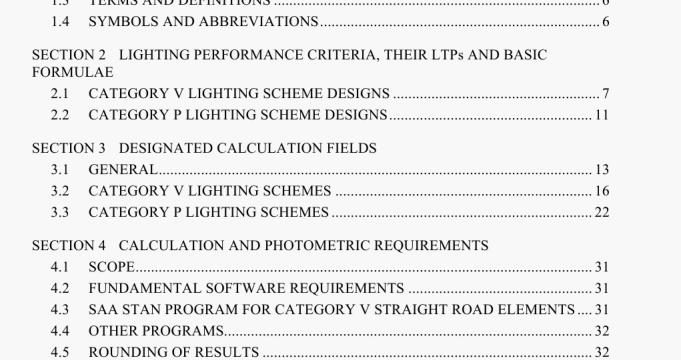Computer procedures for the calculation of light technical parameters for Category V and Category P lighting
AS NZS 1158.2-2020 pdf download.Lighting for roads and public spaces
Part 2: Computer procedures for the calculation of light technical parameters for Category V and Category P lighting.
The calculations shall take into account only the luminous flux contributed from two luminaires, one at either end of the calculation field. Where the transverse positions of the luminaires is unknown, the luminaires shall be assumed to be positioned at a distance one quarter the road reserve width from one property boundary.
NOTE: Where post-top luminaires are to be used care should be taken that the calculation program does not assign an illuminance of zero for a calculation point immediately below the luminaire.
The horizontal illurninance at a point (Eph) shall be calculated in accordance with Clause 2.1.4. For the determination of (JE2, the maximum illuminance shall be taken as the highest value of the calculation points.
(b) Vertical illuminance at a point (Ep) requirements:
(1) calculation field It shall be in accordance with Clause 3.3.5(a).
(ii) calculation points They shall be located on a series of parallel vertical planes. at a height of 1.5 m above the locations specified in Clause 3.3.5(a). The plane shall be orientated to be transverse to the pathway. Calculations shall only be made on the face of each plane facing the first luminaire of the calculation field as shown in Figure 3.8.
In calculating Ep., the illuminance contribution from the luminaire in the adjoining span, that is the luminaire to the left of the first luminaire of the calculation field, may he taken into consideration.
If the luminaires are not symmetrical with respect to either direction of travel then Ep shall be calculated separately for each direction.
The vertical illuminance at a point (Ep) shall be calculated in accordance with Clause 2.2.3.
3.3.7 Public activity areas Including outdoor car parks
Horizontal and vertical illuminance requirements are as follows:
(a) Horizontal illurninance requirements (E, EPh and U):
(I) calculation field It shall cover the area under consideration.
(ii) C’alcultuion points They shall form a grid of uniformly and equally spaced test points in the two directions at an interval of not greater than 5 m. The outermost points shall be not more than 2.5 m from the edge of thc calculation field as shown in Figure 3.9.
The horizontal illuminance at a point (Eph) shall be calculated in accordance with Clause 2.1.4.
(b) Vertical illuminance at a point (Ep.) requirements:
(i) CakulalionfiL’ld It shall be as per Clause 3.3.7(a)(i).
(ii) Calculation points They shall be located on a series of parallel vertical planes. at a height of 1.5 m above the locations specified in Clause 3.3.7(a). except that it shall not be required to calculate Ep for test point locations that are less than 7.5 m from one or morc extremities of the space under consideration as shown in Figure 3.9.
At each applicable point, the calculation of Ep., shall be made for both sides of the vertical plane. The plane may be in any selected orientation.
NOTE: The intention of this requirement is to ensure that, as far as is practicable, light reaching a given point will come from several divergent directions which should ensure reasonable modelling, and therefore recognition, of persons viewed from any orientation.
The vertical illuminance, at a point (Ep) shall be calculated in accordance with Clause 2.2.3.AS NZS 1158.2-2020 pdf download.
Computer procedures for the calculation of light technical parameters for Category V and Category P lighting
